Related Research Articles

An hour is a unit of time conventionally reckoned as 1⁄24 of a day and scientifically reckoned as 3,599–3,601 seconds, depending on conditions. There are 60 minutes in an hour, and 24 hours in a day.

Daylighting is the practice of placing windows, skylights, other openings, and reflective surfaces so that sunlight can provide effective internal lighting. Particular attention is given to daylighting while designing a building when the aim is to maximize visual comfort or to reduce energy use. Energy savings can be achieved from the reduced use of artificial (electric) lighting or from passive solar heating. Artificial lighting energy use can be reduced by simply installing fewer electric lights where daylight is present or by automatically dimming/switching off electric lights in response to the presence of daylight – a process known as daylight harvesting.

Sunrise is the moment when the upper rim of the Sun appears on the horizon in the morning. The term can also refer to the entire process of the solar disk crossing the horizon and its accompanying atmospheric effects.
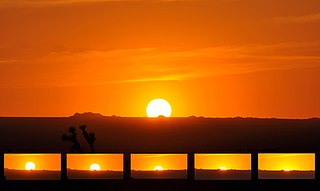
Sunset, also known as sundown, is the daily disappearance of the Sun below the horizon due to Earth's rotation. As viewed from everywhere on Earth, the equinox Sun sets due west at the moment of both the Spring and Autumn equinox. As viewed from the Northern Hemisphere, the sun sets to the northwest in the Northern hemisphere's spring and summer, and to the southwest in the autumn and winter; these seasons are reversed for the Southern Hemisphere.

A lantern is an often portable source of lighting, typically featuring a protective enclosure for the light source – historically usually a candle or a wick in oil, and often a battery-powered light in modern times – to make it easier to carry and hang up, and make it more reliable outdoors or in drafty interiors. Lanterns may also be used for signaling, as torches, or as general light-sources outdoors.

A flashlight, or torch is a portable hand-held electric light. Formerly, the light source typically was a miniature incandescent light bulb but these have been displaced by light-emitting diodes (LEDs) since the mid-2000s. A typical flashlight consists of the light source mounted in a reflector, a transparent cover to protect the light source and reflector, a battery, and a switch, all enclosed in a case.
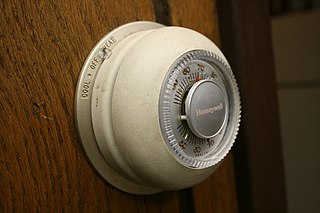
A thermostat is a regulating device component which senses the temperature of a physical system and performs actions so that the system's temperature is maintained near a desired setpoint.
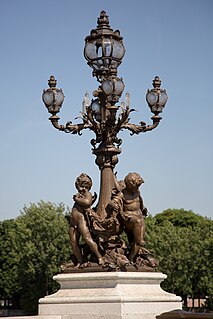
A street light, light pole, lamppost, street lamp, light standard, or lamp standard is a raised source of light on the edge of a road or path. Similar lights may be found on a railway platform. When urban electric power distribution became ubiquitous in developed countries in the 20th century, lights for urban streets followed, or sometimes led.
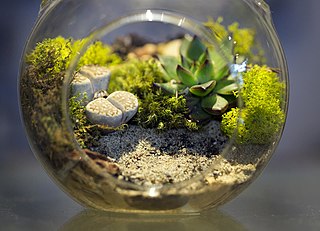
A vivarium is an area, usually enclosed, for keeping and raising animals or plants for observation or research. Often, a portion of the ecosystem for a particular species is simulated on a smaller scale, with controls for environmental conditions.

Building automation is the automatic centralized control of a building's HVAC, electrical, lighting, shading, Access Control, Security Systems, and other interrelated systems through a Building Management System (BMS) or Building Automation System (BAS). The objectives of building automation are improved occupant comfort, efficient operation of building systems, reduction in energy consumption, reduced operating and maintaining costs, increased security, historical performance documentation, remote access/control/operation, and improved life cycle of equipment and related utilities.

A light fixture, light fitting, or luminaire is an electrical device containing an electric lamp that provides illumination. All light fixtures have a fixture body and one or more lamps, though most light fixtures available in stores are in fact light fixture bodies, containing no lamp. The lamps may be in sockets for easy replacement—or, in the case of some LED fixtures, hard-wired in place.

Landscape lighting or garden lighting refers to the use of outdoor illumination of private gardens and public landscapes; for the enhancement and purposes of safety, nighttime aesthetics, accessibility, security, recreation and sports, and social and event uses.
A lighting control system is an intelligent network based lighting control solution that incorporates communication between various system inputs and outputs related to lighting control with the use of one or more central computing devices. Lighting control systems are widely used on both indoor and outdoor lighting of commercial, industrial, and residential spaces. Lighting control systems serve to provide the right amount of light where and when it is needed.
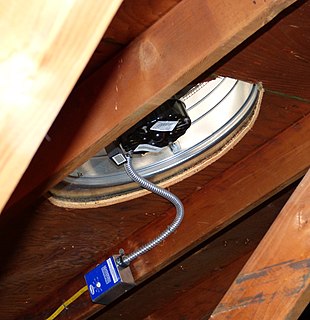
A powered attic ventilator, or attic fan, is a ventilation fan which regulates the heat level of a building's attic by exhausting hot air. A thermostat is used to automatically turn the fan off and on, while sometimes a manual switch is used. An attic fan can be gable mounted or roof mounted. Additional vents are required to draw in the fresh air as the hot air is exhausted. Attic fans are typically used in warmer months, when temperatures in an attic can exceed 120 °F (49 °C). A fan may be installed in an attic for the different purpose of cooling a whole house, venting hot air out via the attic; such fans are often called whole-house fans.
A solar controller is an electronic device that controls the circulating pump in a solar hot water system to harvest as much heat as possible from the solar panels and protect the system from overheating. The basic job of the controller is to turn the circulating pump on when there is heat available in the panels, moving the working fluid through the panels to the heat exchanger at the thermal store. Heat is available whenever the temperature of the solar panel is greater than the temperature of the water in the heat exchanger. Overheat protection is achieved by turning the pump off when the store reaches its maximum temperature and sometimes cooling the store by turning the pump on when the store is hotter than the panels.
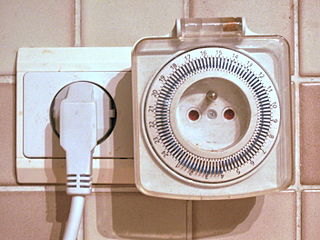
A time switch is a timer that operates an electric switch controlled by the timing mechanism.

A solar lamp, also known as a solar light or solar lantern, is a lighting system composed of a LED lamp, solar panels, battery, charge controller and there may also be an inverter. The lamp operates on electricity from batteries, charged through the use of solar panel
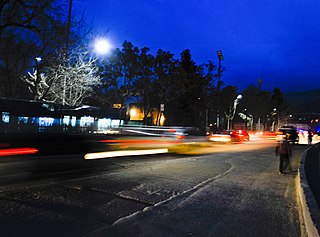
Solar street lights are raised light sources which are powered by solar panels generally mounted on the lighting structure or integrated into the pole itself. The solar panels charge a rechargeable battery, which powers a fluorescent or LED lamp during the night.

The Helios House is a gas station in Los Angeles, located on Olympic Boulevard. It is designed as a green station with special features and is considered to be the "station of the future." It is the first gas station in the world ever to be submitted for LEED certification.

Solar traffic lights are signalling devices powered by solar panels positioned at road intersections, pedestrian crossings and other locations to control the flows of traffic. They assign the right of way to road users by the use of lights in standard colors, using a universal color code.
References
- ↑ Pendrous, Claire (2005). "Switching devices". Midland Counties Street Lighting. Retrieved 2016-03-22.(Domain home page is 404; archive copy, 2010-02-25, accessed 2016-03-22.)
- ↑ "Sangamo Time Switches and Heating Controls". Sangamo. Port Glasgow, Renfrewshire, UK: Sangamo Ltd. Retrieved 2016-03-22.